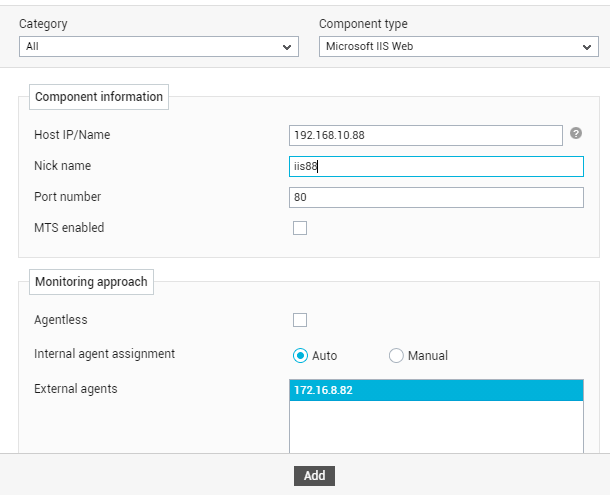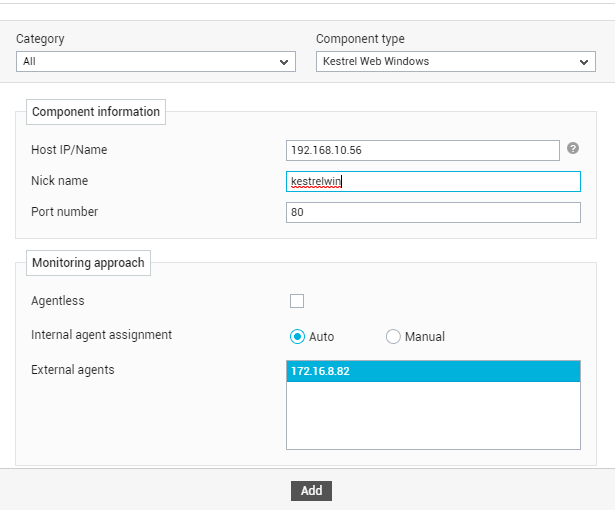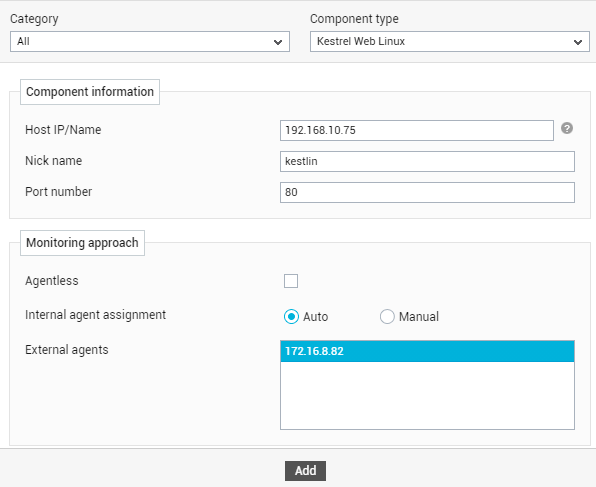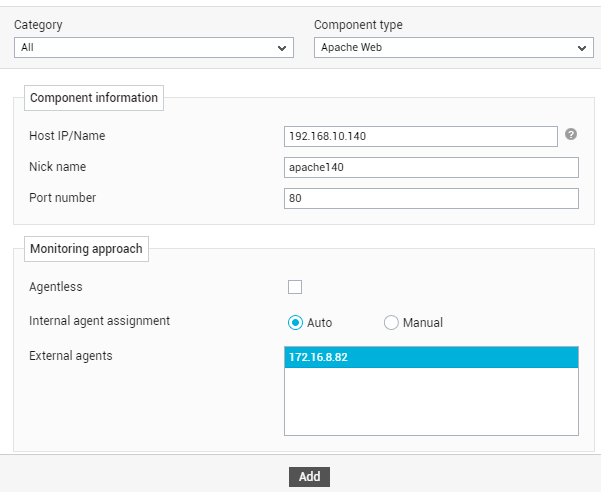Managing the Target .NET Core Application
The next step is to manage the .NET Core application using the eG admin interface. The procedure for this varies based on where the application is running - whether on a Kestrel web server on Linux, an IIS web server, or any other web server on Windows - and how users access the application - whether directly or via a proxy server.
Managing the IIS Web Server that Hosts .NET Core Applications
If the target .NET Core application is running on an IIS web server and is accessed directly by users, then you need to manage that IIS web server as a Microsoft IIS Web component in eG Enterprise. For this, do the following:
-
Login to the eG admin interface.
-
Follow the Infrastructure -> Components -> Add/Modify menu sequence in the Admin tile.
-
From the Component type drop-down in the page that appears next, select Microsoft IIS Web and click the Add New Component button. Figure 1 will then appear.

-
Provide the Host IP/Name of the target IIS web server, assign a unique Nick name to the server, and configure the Port number at which IIS listens for requests from clients. Then, assign External agents to externally monitor the network connectivity and traffic of the IIS web server, and click the Add button to add the server to the eG Enterprise system.
If multiple .NET Core web sites/applications are running on the same IIS web server, and you wish to monitor each of them, then you can add a separate Microsoft IIS Web component in eG Enterprise for each web site to be monitored (OR ) you can add a single component with WEBSITENAME as ALL.
Managing the Web Server on Windows that Hosts .NET Core Applications
If the target .NET Core application is running on a web server on Windows (but not the IIS web server), and users directly connect to that web server to access the application, then, manage that web server as a Kestrel Web Windows component in eG Enterprise. To achieve this, follow the steps below:
-
Login to the eG admin interface.
-
Follow the Infrastructure -> Components -> Add/Modify menu sequence in the Admin tile.
-
From the Component type drop-down in the page that appears next, select Kestrel Web Windows and click the Add New Component button. Figure 2 will then appear.

-
Provide the Host IP/Name of the target Kestrel web server and assign a unique Nick name to the server. Against Port number, specify the port number at which the target .NET Core web site / application listens for requests. Then, assign External agents to externally monitor the network connectivity and traffic of the IIS web server, and click the Add button to add the server to the eG Enterprise system.
If multiple .NET Core web sites/applications are running on the same web server, and you wish to monitor each of them, then you can add a separate Kestrel Web Windows component in eG Enterprise for each web site/application to be monitored. When adding the components using the eG admin interface, make sure to configure every component with a different port number - one each for every target web site/application.
Managing the Stand-alone Kestrel Web Server on Linux that Hosts .NET Core Applications
If the target .NET Core application is running on a stand-alone Kestrel web server on Linux, and the users access that application by directly connecting to that web server, then manage that web server as a Kestrel Web Linux component in eG Enterprise. This can be achieved by following the steps discussed hereunder:
-
Login to the eG admin interface.
-
Follow the Infrastructure -> Components -> Add/Modify menu sequence in the Admin tile.
-
From the Component type drop-down in the page that appears next, select Kestrel Web Linux and click the Add New Component button. Figure 3 will then appear.

-
Provide the Host IP/Name of the target Kestrel web server and assign a unique Nick name to the server. Against Port number, specify the port number at which the target .NET Core web site / application listens for requests. Contact the application developer / administrator to know the port number at which the target web ste/application listens. This will be the Then, assign External agents to externally monitor the network connectivity and traffic of the Kestrel web server, and click the Add button to add the server to the eG Enterprise system.
If multiple .NET Core web sites/applications are running on the same web server, and you wish to monitor each of them, then you can add a separate Kestrel Web Linux component in eG Enterprise for each web site/application to be monitored. When adding the components using the eG admin interface, make sure to configure every component with a different port number - one each for every target web site/application.
Managing a Kestrel Web Server on Linux that Uses an Apache Web Server as a Reverse Proxy
Sometimes, a .NET Core application may be running on a stand-alone Kestrel web server on Linux. However, user requests to that application may be routed via a Apache web server proxy running on a different machine. In this case, to monitor the .NET Core application, you will have to manage the Kestrel web server as a Kestrel Web Linux component in eG Enterprise, as depicted by Figure 3. However, for end-to-end visibility into the performance of the entire web site / web application service, you may have to monitor the Apache web server as well (as shown by Figure 4).
At some other times, the Apache web server proxy may operate on the same Linux host as the Kestrel web server. In this case, to monitor transactions to the .NET Core application, it would suffice to manage the Apache web server alone using the eG admin interface. You will not have to manage the Kestrel web server at all. The steps to be followed in this case are as follows:
-
Login to the eG admin interface.
-
Follow the Infrastructure -> Components -> Add/Modify menu sequence in the Admin tile.
-
From the Component type drop-down in the page that appears next, select Apache Web and click the Add New Component button. Figure 4 will then appear.

-
Provide the Host IP/Name of the target Apache web server and assign a unique Nick name to the server. Against Port number, specify the port number at which the Apache web server listens. Then, assign External agents to externally monitor the network connectivity and traffic of the Apache web server, and click the Add button to add the server to the eG Enterprise system.



